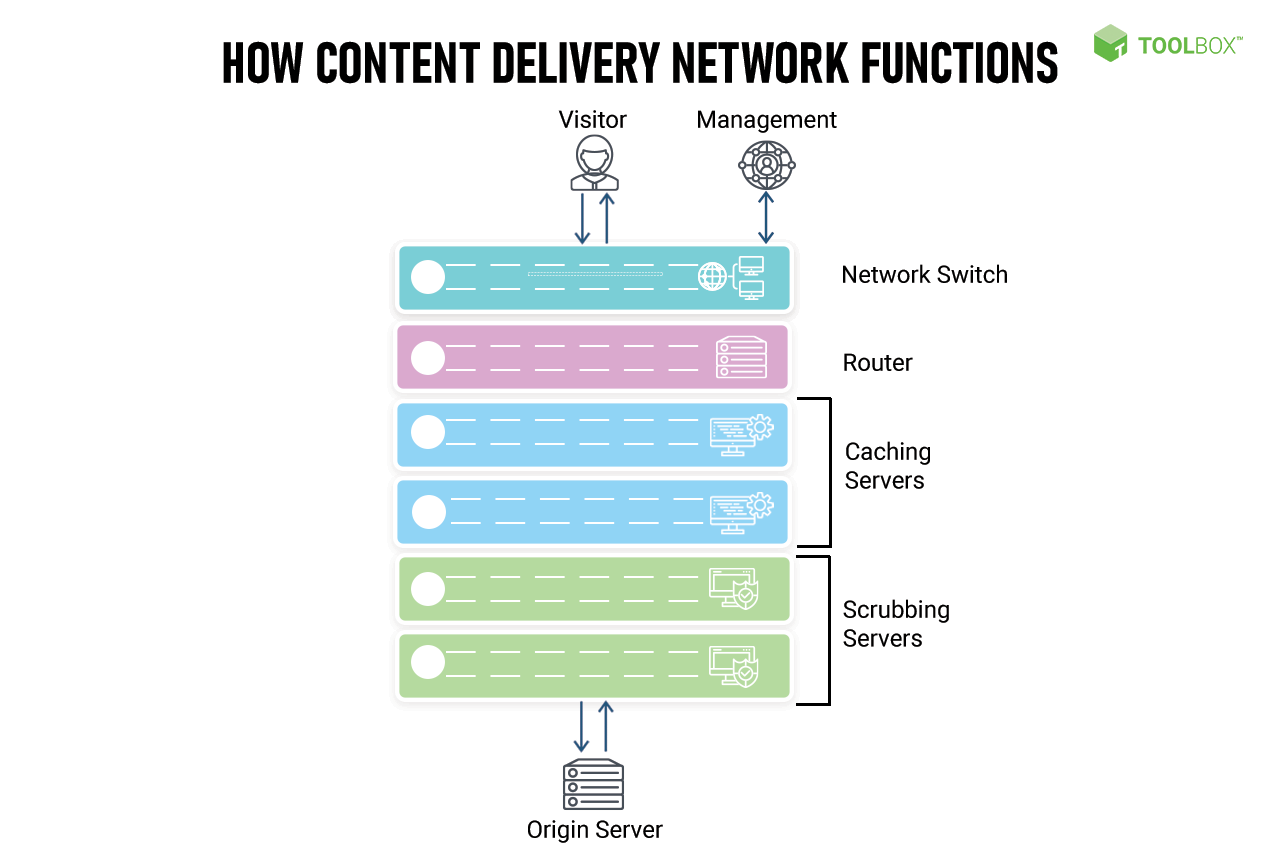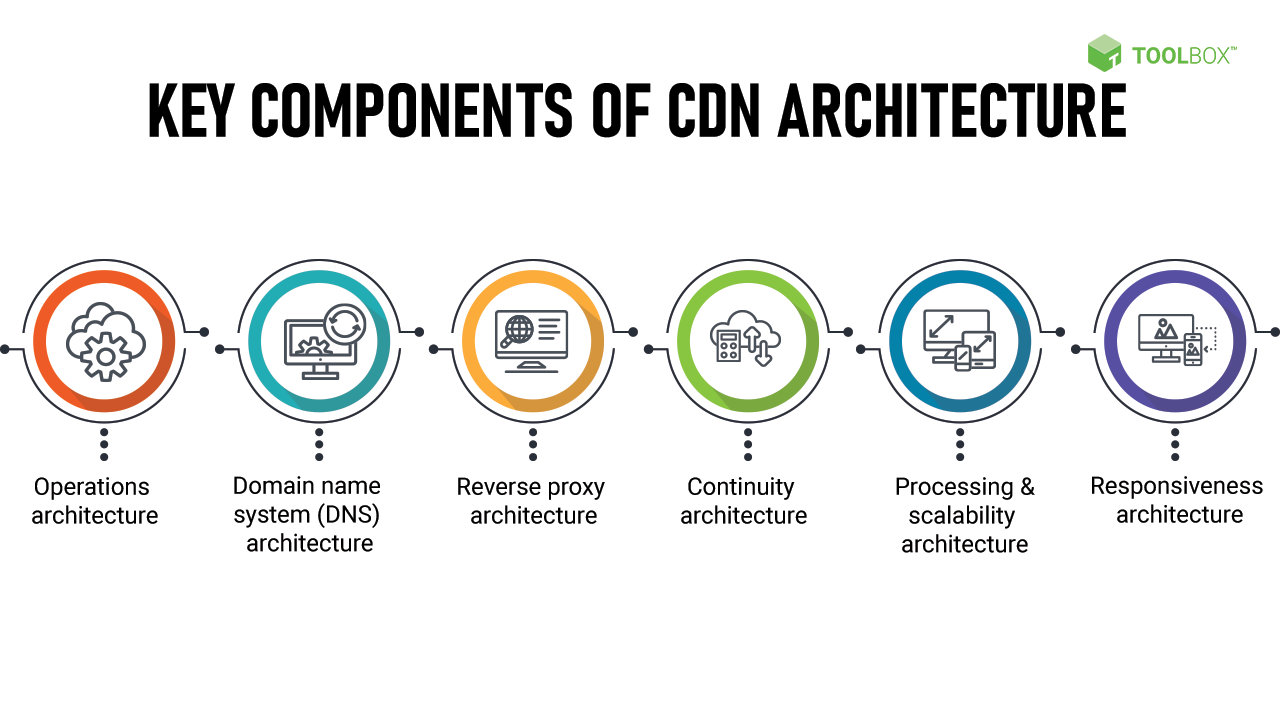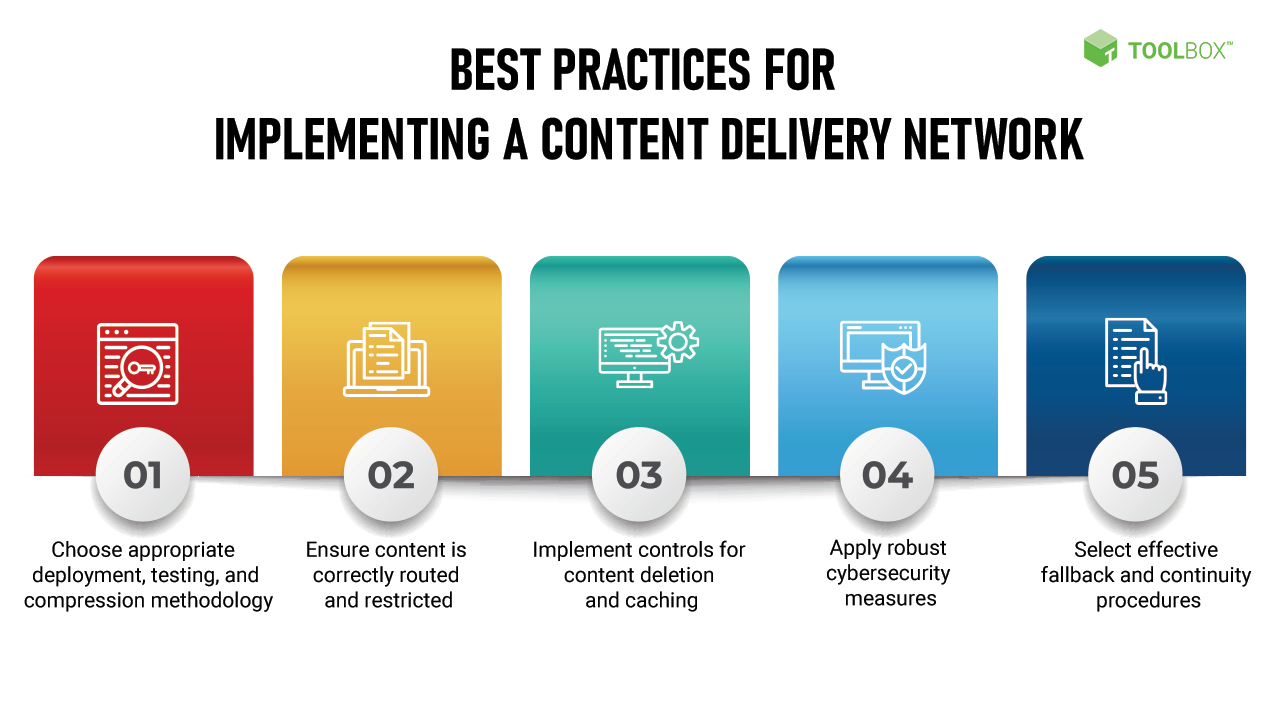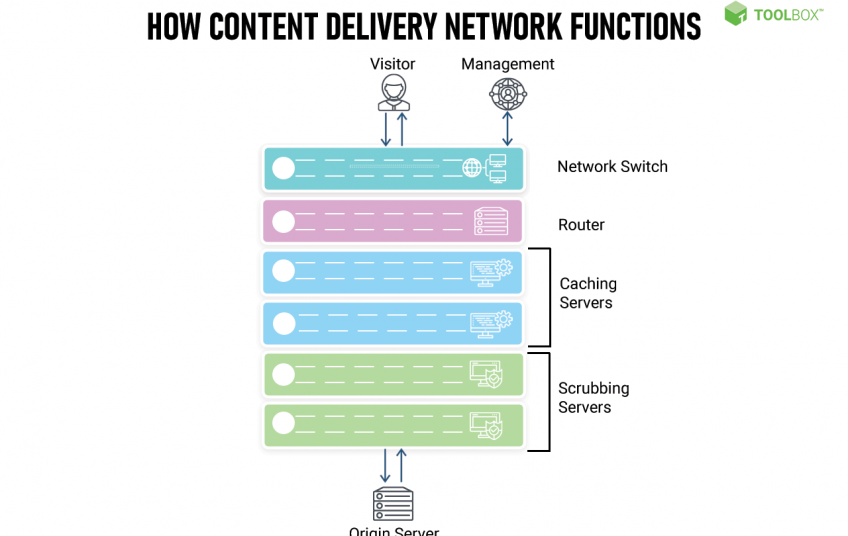A content delivery network consists of distributed servers that minimize web page loading times by bringing servers and users physically closer.
A content delivery network is defined as a group of highly distributed servers that work in unison to help ensure minimal delays in loading web page content by reducing the geographical distance between users and servers. This article explains a content delivery network and its components in detail and shares useful best practices for content delivery network implementation in 2021.
What Is a Content Delivery Network (CDN)?
A content delivery network is a group of highly distributed servers that work in unison to help ensure minimal delays in loading web page content by reducing the geographical distance between users and servers.
The attention span of the average online consumer is becoming shorter day by day. At the same time, technology is racing ahead to never-seen-before levels. Therefore, delivering content quickly could be the difference between retaining customers and losing them, maybe even forever. Choosing the right CDN provider can help businesses and other content providers serve their content to readers swiftly, efficiently, and securely.
CDNs allow users to enjoy the content at consistently high quality without having to deal with lag and slow loading times, regardless of geographic location. CDNs are normally used to deliver static content, including images, documents, style sheets, HTML pages, and client-side scripts.

CDNs are physically located closer to end users, thus minimizing round-trip time and improving the overall online experience. Users rely on content delivery networks to prevent their content origin servers from having to respond to all end-user requests by themselves. This minimizes the traffic levels that the origin servers deal with, reduces load levels, and decreases the probability of origin server failure in case of very high traffic spikes or persistent loads. A large amount of content on the internet is delivered using CDNs. They ensure minimal latency levels by removing the delay between requesting web page content and the said web page loading on the end user’s device.
Let’s look at an example.
A visitor located in Asia wishes to view content that is stored on a North American origin server. If the data had to travel from the origin server to this visitor’s device, poor loading times are all but guaranteed. However, this delay can be avoided by deploying a CDN that caches a copy of the content in a country geographically closer to the end user. Such a CDN is known as a point of presence (PoP). Every PoP normally contains a caching server that helps deliver content to geographically diverse end users with minimum delays.
Although CDNs are primarily used to deliver website content, it’s not their only use case. They also deliver other content types such as high-quality video and audio, medical, financial, and other data records, and apps, OS updates, and software. Nearly all forms of digitized information can be delivered using a content delivery network.
How does a CDN work?
A content delivery network typically functions in the following steps:
-
Step 1: A user-agent (the device that runs the end user’s web browser) sends a request for content, such as images, JavaScript files, HTML, and CSS, required to show web pages.
-
Step 2: Each request is assigned to the most optimum CDN server.
-
Step 3: Each CDN server reverts with a previously saved (cached) version of the requested content.
-
Step 4: If the requested content is not found on the most optimum server, the files are retrieved from another server on the CDN platform.
-
Step 5: If the requested content is either stale or unavailable even on other CDNs within the platform, a request is sent to the origin server.
This newly requested content is then stored to fulfill future requests.

1. Operations architecture
The main aim of a CDN is to fight latency. Architecturally speaking, this means building CDNs with optimal levels of connectivity. In the real world, this translates to PoPs being placed at every major traffic hotspot across the globe, with networking hubs intersecting this architecture to ensure the smooth transmission of data.
Physical facilities are critical for peak CDN performance. Generally speaking, PoPs should be located at premium data centers, with core providers engaging in peer-oriented behavior. This means that CDN providers must establish peering agreements with other CDN vendors and major traffic carriers. Through such agreements, CDNs can significantly enhance bandwidth utilization and decrease round-trip times.
2. Domain name system (DNS) architecture
The DNS component of CDN architecture works to direct requests to the closest and most viable CDN server. In the case of DNS requests for CDN-handled domain names, the server assigned to process these requests determines which set of servers is best suited to handle the incoming request. At the simplest level, DNS servers execute geographic lookups on the basis of IP address and lead the request to the geographically closest edge server.
3. Reverse proxy architecture
CDNs rely on reverse proxies for functions such as imitation of the website server, caching, and firewall protection. Key aspects of the reverse proxy layer include web application firewall (WAF), bot blocking, and split (A/B) testing.
4. Continuity architecture
Many CDN platforms often see glitches in their daily operations. Therefore, the architecture to ensure continuity in CDN performance is of critical importance. Vendors often invest in resilient, highly available architecture to commit to 99+ percent service level agreements (SLAs). CDN providers choose an architecture that is designed to ensure no failure at any given single point of contact. This is achieved by scheduling maintenance cycles in a planned manner, among other measures.
Adoption and integration of redundancy software and hardware into existing CDN architecture also helps ensure robust continuity. This can be in the form of internal systems for failover and disaster recovery. Such systems normally feature auto-routing of traffic to bypass downed servers. For enhanced reliability, CDN providers enter agreements with multiple leading data carriers. They also establish dedicated out-of-band channels for communication and management that enable them to interact with, control, and manage CDN servers in demanding situations.
5. Processing and scalability architecture
CDNs are built for swift routing of high volumes of data. Therefore, content delivery network architecture is designed with two expectations: processing traffic swiftly & efficiently and scaling processing power according to data volume. These expectations are addressed by providing ample processing and networking resources that are scalable at every level of operation. These resources include scalable architecture for computing, caching, cybersecurity, and routing.
CDN vendors offering distributed denial of service (DDoS) protection naturally require architecture with higher levels of processing power and scalability. Therefore, such vendors adopt dedicated scrubbing servers for countering DDoS threats. Each of these servers can handle network-level traffic volumes and process tens of gigabytes of data per second.
6. Responsiveness architecture
Responsiveness can be measured by calculating the time taken for modifications in network-wide configuration to take effect. CDN vendors generally strive to maximize responsiveness through cutting-edge architecture.
However, ensuring peak responsiveness can be difficult, especially for networks spanning across the globe. The tiniest changes in configuration need to be rapidly and effectively communicated to all PoPs on the global CDN platform. Examples include a request to delete all instances of a particular image across caches or add an address to a list of blacklisted IPs.
The larger a network and the wider its geographical presence, the higher the effort required to achieve peak responsiveness. To ensure high levels of responsiveness, CDN architecture needs to be constructed while prioritizing swift configuration propagation.
Advantages of Implementing a CDN
For entities with the correct use case, there are numerous advantages of adopting a CDN solution. Some of these have been outlined below.
1. Minimized latency
Decreasing the loading time of websites is the prime advantage offered by CDN solutions. With a CDN, content is distributed across a wider geographical area, bringing it closer to website visitors worldwide. By decreasing the distance between their content and end-users, enterprises and content providers help ensure an enhanced experience for all stakeholders.
As the post-pandemic world becomes more and more digitalized, it has become less likely that users will stay on or revisit websites that take longer to load. CDNs can decrease bounce rates and boost favorable metrics such as website visits and the average time spent by users on the website. Simply put, a CDN-enhanced website translates to more visitors and longer visits.
Content delivery networks are distributed across the globe. As such, users can get their data from a physically closer data center instead of waiting for it to reach them from wherever the origin server lies. The lesser the travel time, the better the online experience is bound to be.
Further, CDNs minimize the quantity of transferred data using file compression and other minification methods to decrease file sizes. Smaller files mean reduced load times. CDNs can also boost the speed of websites that use TLS/SSL certificates through measures such as TLS false start and optimized connection reuse.
By combining a content delivery network with other hardware- and software-based optimization techniques, data can be transmitted to end users at even higher speeds. Examples of such optimization include solid-state hard drives (SSDs) and efficient load balancing.
2. Increased reliability
By adopting a CDN, content providers can ensure that their websites are always available. CDNs counter interruptions caused by factors such as high traffic volume or hardware failure. Due to their distributed presence, they can process large amounts of data traffic and tolerate concurrent hardware failures.
Uptime is one of the most important components for any digital content provider. In today’s world, many users are simply unwilling to wait for online content, and it takes only one website outage to push a percentage of end users into the waiting arms of competitors. CDNs address this issue by countering both hardware failures and traffic spikes. Whether it’s caused by a malicious attack or an increase in the website’s popularity, a content delivery network will prevent the website from going down.
Leading CDN vendors provide numerous features that help minimize downtime, including:
-
Intelligent failover: This ensures uninterrupted uptime even when more than one server stops working due to hardware malfunction. With this feature, traffic is redistributed to other servers to ensure continuity.
-
Load balancing: This allocates network traffic equally across numerous servers to deal with any amount of increased traffic at scale.
-
Anycast routing: This transfers data traffic to another available data center if an entire data center is unavailable due to any technical issues.
3. Decreased bandwidth costs
One of the primary costs incurred by digital content providers is the consumption of bandwidth for website hosting. Bandwidth consumption occurs whenever an origin server sends a response to a content request. One of the primary features of a CDN is reducing the data that an origin server needs to transmit. This helps website owners see a reduction in their hosting costs. CDNs also help minimize bandwidth costs through optimization measures such as caching.
4. Enhanced cybersecurity
Finally, CDNs help protect data through measures such as enhanced security certificates and DDoS mitigation. Leading vendors integrate several information security features into their CDN solutions. One such feature is the TLS/SSL certification that enables CDNs to secure websites more effectively. CDNs also help ensure robust authentication, integrity, and encryption standards for websites.
Top 5 Best Practices for Implementing a Content Delivery Network in 2021
In the post-pandemic world, content providers are leveraging CDN solutions more than ever before to enhance the performance and availability of their digital content. Below are five best practices that companies and content providers should consider when implementing a content delivery network in 2021.

1. Choose an appropriate deployment, testing, and compression methodology
If static content is not included within the application deployment process or package, its provisioning and deployment may occur separately from the application. Stakeholders need to consider how the versioning approach used to manage static resource content and application components will be affected by the chosen deployment method.
Additionally, techniques such as minification and bundling can be used to minimize website load times. Minification works to remove redundant characters from CSS files and scripts while retaining their functionality. Bundling merges numerous files to create a single file.
Further, the deployment process needs to be modified in the case of content that needs to be deployed in more than one location. In the case of application-side updating of content for the CDN, instances of the updated content need to be stored at the CDN endpoint and additional locations. This updating can take place either at fixed, predetermined intervals or through specific triggers.
Handling local testing and development activities in cases where static content needs to be served by the CDN is another point that needs to be considered. One option is the use of a build script that pre-deploys the content to the CDN. An alternative to this is the use of flags or compile directives to manage the way resources are loaded by the application. For instance, the application could be set to load static content through local channels when in debug mode and use the CDN when in release mode.
Finally, options for file compression, such as GNU zip, can be considered for execution, either directly by the CDN on edge servers or by the web application hosting on origin servers.
2. Ensure content is correctly routed and restricted
The use of different CDNs for various situations needs to be taken into account. For instance, using a new CDN to deploy a new application version can be considered to retain the preceding application versions on the previous CDN. Similarly, older content formats can be held on one CDN, while newer formats can be deployed on a fresh CDN. Some leading providers offer a form of ‘blob storage’ that can be used as the origin point of content. This can be used to create a distinct storage account or container to which the CDN endpoint can be routed.
Using the query string for denoting varying application versions in links to CDN resources is not recommended for some CDN providers. This is because the query string is included within the resource’s name during content retrieval, and the caching of resources by the client can be affected. Further, when past versions of static content are already cached on a CDN, deploying new resource versions through application updates can be challenging. The cache control measures outlined in the next point can help in such cases.
Finally, content providers often need to restrict access to CDN content based on country or region. This can be due to regulatory, legal, or other reasons. CDN vendors often enable the filtering of requests by users based on the geographic point of origin and allow restriction of content delivery accordingly.
3. Implement controls for content deletion and caching
Making objects unavailable from the CDN can be achieved by deleting the content from the server of origin. Another option is the deletion or removal of the object from the CDN endpoint. The blob or container can also be changed to ‘private’ when blob storage is available. However, it should be noted that CDN content may not be fully removed until the expiry of the hop limit. The manual purging of a CDN endpoint may be a viable option in some cases.
The management of caching in the CDN ecosystem also needs to be considered. Some leading CDN providers allow users to define caching rules globally. Custom caching options for specific origin endpoints can also be implemented as required. Finally, users can control a CDN’s caching performance by transmitting cache-control headers at the origin.
4. Apply robust cybersecurity measures
Delivery of content using HTTPS (SSL) is possible through a CDN-provided certificate and standard HTTP. Browser warnings regarding ‘mixed content’ can be avoided using HTTPS for requesting static content. This helps display content on pages that are loaded over HTTPS.
Users may encounter issues regarding the same-origin policy. This can happen when an XMLHttpRequest call is used for requesting content from another domain. Such issues may be seen in cases where a CDN is used to deliver font files and other static assets.
In cases where the webserver is not configured to assign the applicable response headers, web browsers are likely to disable cross-origin resource sharing (CORS). To overcome this, one of the methods listed below can be used for configuring CDNs to enable CORS.
-
CORS rules can be added to the storage endpoint when blob storage is the point of origin.
-
The CDN can be configured to include CORS headers within the responses.
-
The application can be configured to set CORS headers.
5. Select effective fallback and continuity procedures
Cutting-edge CDNs boast of near-constant availability even in the face of widespread system failure. However, it may be wise for large-scale content providers to consider fallback options, especially those dealing in sensitive or critical content. Therefore, the reaction of the application in case of either temporary CDN unavailability or complete CDN failure should be accounted for.
One option worth considering is setting up client applications to use copies of the content that was locally cached during prior requests. Another option is the inclusion of code for failure detection. In the latter case, resource requests can instead be routed from the origin server in case of CDN unavailability.
Takeaway
Today, businesses across verticals need an online presence to survive, making content delivery networks a must-have. Enterprises, especially smaller ones that operated solely or mostly offline before the COVID-19 pandemic, are facing many challenges. These challenges lie in the areas of content delivery, content adjustment according to end-user device type, and the secure handling of data. CDNs have several features that are perfectly suited to help content providers overcome these challenges speedily and at scale.





